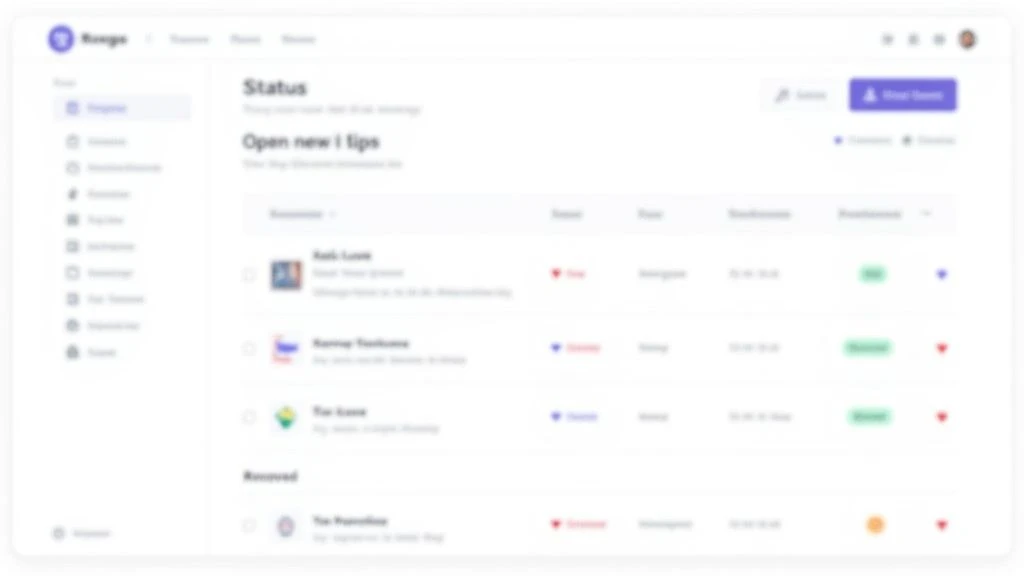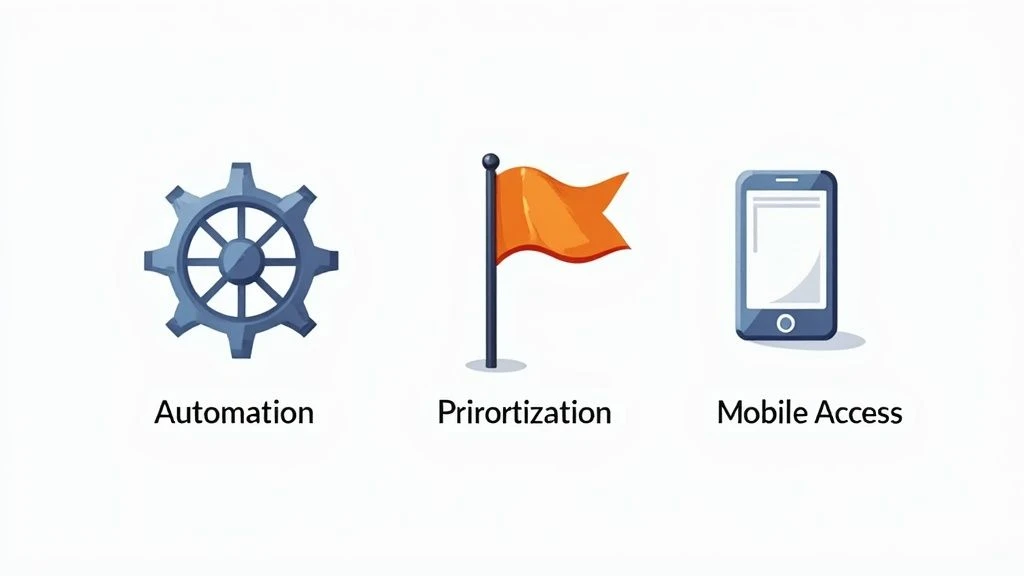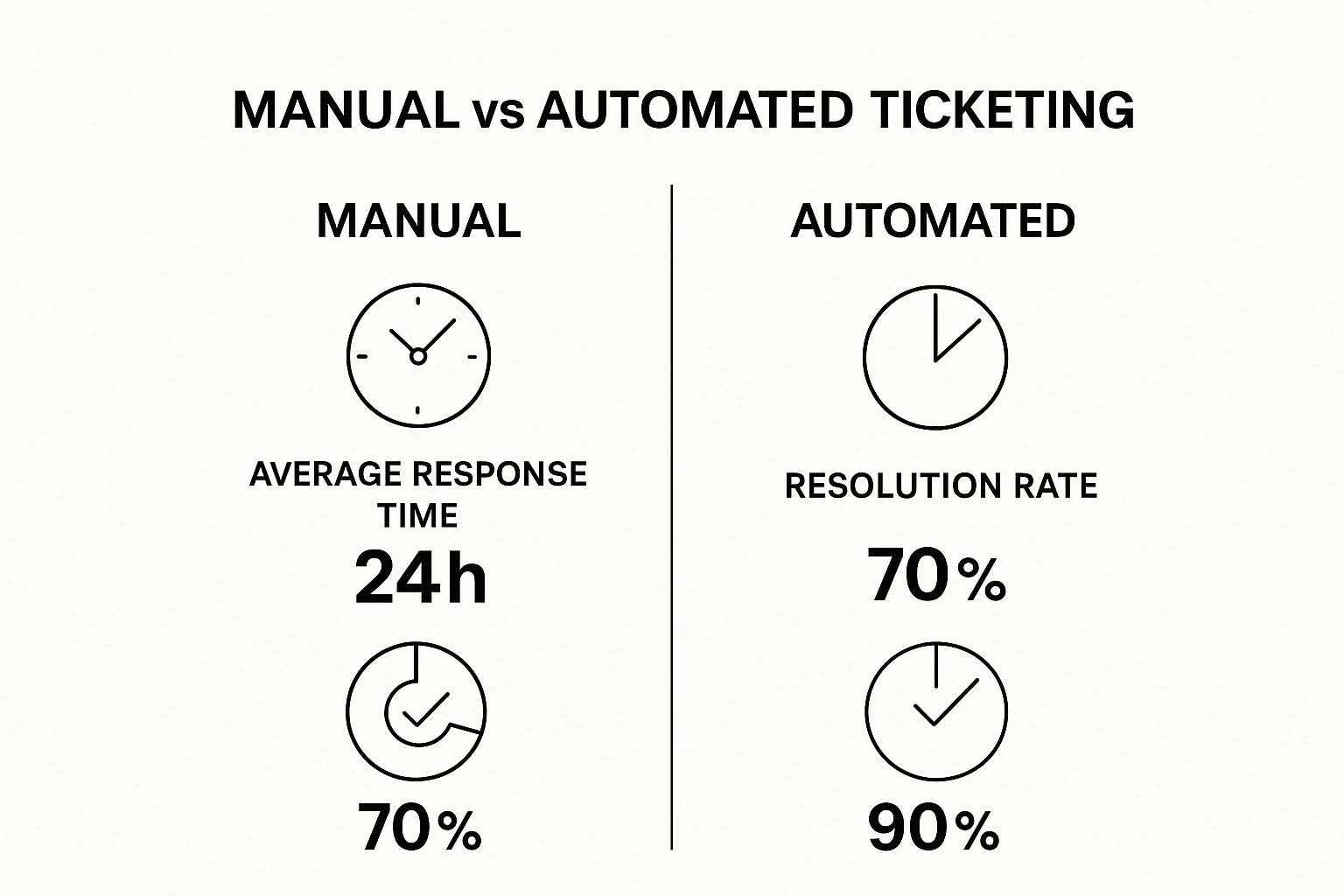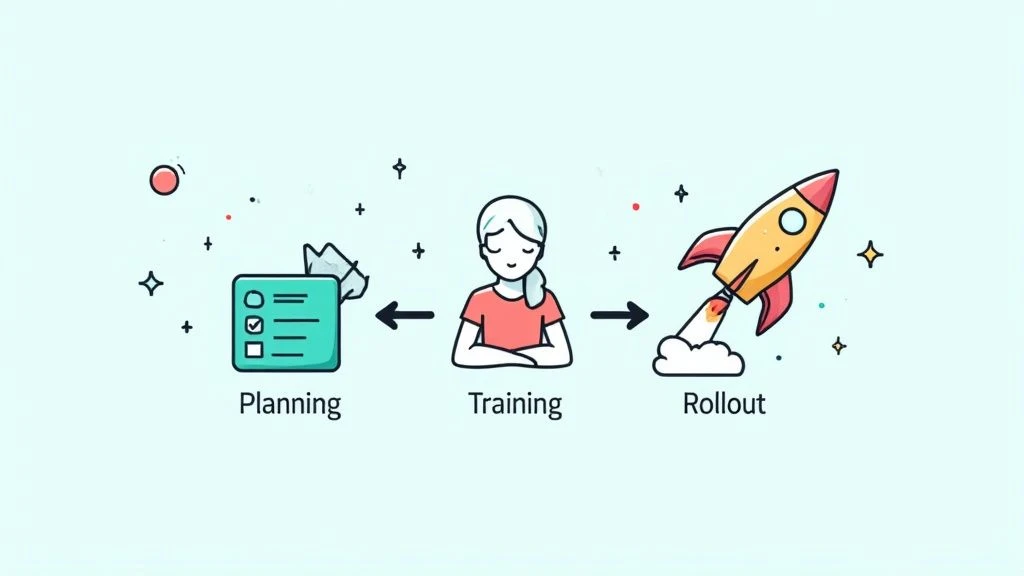Mastering the Service Ticketing System for Better Support
May 11, 2025The Evolution of Modern Service Ticketing Systems

Early service ticketing systems often resembled shared email inboxes. This led to a disorganized and inefficient approach to customer support. Tracking requests, ensuring timely responses, and maintaining accountability were significant challenges. The result? Frustrated customers and overwhelmed support teams. This reactive approach focused on fixing immediate problems, rather than preventing them.
Modern service ticketing systems, however, have dramatically improved the process. They’ve become sophisticated platforms that form the operational core of many organizations. This represents a significant shift toward proactive service. Businesses can now anticipate customer needs and create smooth, positive experiences.
From Reactive to Proactive: A Fundamental Change
This evolution isn't just about new technology. It's about changing the entire service delivery philosophy. Forward-thinking businesses use service ticketing systems for more than just managing incoming requests. They use them to understand customer behavior and find areas to improve.
Support interactions become opportunities to collect data, improve products, and strengthen customer relationships. Features like automated ticket routing and predefined macros ensure inquiries reach the right agent quickly. Integrated knowledge bases also empower customers to find solutions on their own.
The Growing Importance of the Market
The growth of the service ticketing system market highlights its increasing value. Historically, the market, especially for smart ticketing, has grown thanks to technological advancements and changing consumer needs. In 2024, the global smart ticketing market was estimated to be worth between USD 10.6 billion and USD 13.26 billion.
It’s projected to reach about USD 31.65 billion by 2030, with a CAGR of roughly 15.70%. This growth is fueled mainly by increased mobile ticketing adoption. This offers convenience for users and provides businesses with valuable data on passenger behavior. You can find more detailed information in this Smart Ticketing Market Report.
Key Features of a Modern System
What distinguishes robust service management platforms from simple email inboxes? Here are some key components:
- Multi-channel integration: Combining all communication channels (email, live chat, social media) into a single platform.
- Automation: Automating tasks like ticket routing, notifications, and escalations.
- Self-service capabilities: Giving customers the ability to find answers through knowledge bases and FAQs.
- Reporting and analytics: Tracking important metrics to identify trends and evaluate performance.
Businesses that avoid implementing these modern systems face increasing challenges. They struggle to meet customer expectations, experience lower efficiency, and risk losing valuable customers to competitors who prioritize excellent service. As the service landscape changes, the role of a robust service ticketing system will only become more vital for success.
Tangible Benefits That Transform Service Delivery

A service ticketing system does more than just organize; it fundamentally changes how businesses handle both customer support and internal service requests. These platforms create accountability, turning disorganized workflows into structured, measurable processes. This allows teams to move from simply reacting to problems to proactively addressing them and even preventing future issues.
Faster Response and Higher Resolution Rates
One of the most immediate advantages is a noticeable drop in response times. By automating ticket routing and prioritizing urgent issues, a service ticketing system makes sure inquiries get to the right agent quickly. This leads to higher resolution rates because agents have the necessary information and tools to solve customer problems efficiently. This also frees them up to focus on more complex issues instead of getting bogged down with simple, repetitive tasks. Check out our guide on How to pick the best helpdesk software for small business.
Boosting Productivity and Eliminating Chaos
Think about a workplace where email chains and spreadsheets no longer control the service workflow. Service ticketing systems do away with this digital clutter, saving valuable time and increasing overall productivity. By centralizing all service requests, these systems offer a single source of truth for all customer interactions. This means teams can easily track progress, share information, and avoid duplicated work.
Transforming Conversations into Knowledge
Every interaction within a service ticketing system becomes a valuable piece of data. This information can be analyzed to identify trends, understand customer behavior, and improve service delivery. Over time, these service interactions build a powerful knowledge base that benefits the whole organization. This shared knowledge helps agents resolve issues faster and gives valuable insights for product development and business strategy. For instance, noticing common customer issues can lead to improvements in product design or documentation.
To illustrate the department-specific benefits, let's take a look at the following table:
Service Ticketing System Benefits by Department
This table shows how different departments benefit from implementing a service ticketing system, highlighting specific advantages for each area of business operation.
| Department | Primary Benefits | Efficiency Gains | ROI Indicators |
|---|---|---|---|
| Customer Support | Reduced response times, improved customer satisfaction | Faster issue resolution, reduced handle time | Increased customer retention, higher customer lifetime value |
| IT | Streamlined incident management, improved asset tracking | Faster problem diagnosis, reduced downtime | Increased system uptime, reduced IT costs |
| HR | Centralized employee requests, improved onboarding processes | Faster response to employee inquiries, reduced paperwork | Improved employee satisfaction, increased HR efficiency |
| Marketing | Improved lead management, better campaign tracking | Faster lead qualification, improved campaign ROI | Increased conversion rates, higher marketing ROI |
As you can see, the benefits of a service ticketing system extend across multiple departments, leading to overall improvements in efficiency, customer satisfaction, and ROI.
Outperforming the Competition
Teams that use a service ticketing system effectively consistently outperform their competitors. They achieve higher customer satisfaction scores, demonstrate greater efficiency, and often find new revenue opportunities through improved service offerings. This mastery of service delivery strengthens customer loyalty and drives long-term business growth. A robust service ticketing system ultimately becomes a key differentiator in a competitive market.
Critical Features That Drive Exceptional Service

The infographic above highlights the positive impact of automated ticketing systems. It visually demonstrates how these systems drastically reduce response times and boost resolution rates compared to manual processes. This leads to a much better customer experience and more efficient use of valuable support resources.
Not all service ticketing systems offer the same capabilities. Some truly elevate service operations, while others may lack practical value in real-world situations. Understanding these key differences is crucial for making the right choice for your organization.
Customization Capabilities: Finding the Right Balance
Customization is essential, but too much can be detrimental. While some flexibility is key, over-customization can create a complex system that’s difficult to maintain. The ideal service ticketing system offers a balance. It should meet your specific needs without becoming overly complicated. Focus on features like custom fields for targeted data and automated routing rules to streamline workflows and improve efficiency. How to master help desk best practices offers further insights. Avoid excessive customization that could burden your team.
Multichannel Integration: The Key to Seamless Communication
Customers expect to connect through various channels like email, live chat, social media, and phone. A robust service ticketing system integrates these channels into a single platform. This multichannel integration ensures all customer interactions are tracked and managed effectively, regardless of their origin. Seamless communication is vital for excellent customer service. To learn more about the advantages of live chat, check out this article on the benefits of live chat for customer service.
Intelligent Automation: Preventing Frustration for Everyone
Automation optimizes service operations. Features like automated ticket routing, notifications, and escalations reduce manual work and improve response times. This not only boosts agent productivity but also prevents customer frustration by ensuring prompt and efficient handling of inquiries.
Self-Service vs. Human Intervention: Striking the Right Balance
Self-service resources, like knowledge bases and FAQs, empower customers to find answers independently. This frees up support agents to handle more complex issues. However, finding the right balance is crucial. While self-service is valuable, it shouldn't completely replace human interaction. Customers should always have access to a human agent when necessary. Interestingly, the sports and entertainment sector valued smart ticketing at USD 12 billion in 2024. You can explore more about the smart ticketing market.
The following table provides a detailed comparison of key features available across different tiers of service ticketing solutions. This information is designed to assist organizations in identifying the capabilities that best align with their specific requirements.
Top Service Ticketing System Features Comparison A detailed comparison of critical features across different tiers of service ticketing systems to help organizations identify which capabilities align with their specific needs
| Feature Category | Basic Systems | Mid-Range Solutions | Enterprise Platforms |
|---|---|---|---|
| Customization | Limited custom fields and basic workflows | Customizable fields, forms, and workflows | Highly customizable with API access and advanced integrations |
| Multichannel Integration | Email and basic web forms | Email, web forms, social media, and chat integration | Omnichannel support including voice, SMS, and mobile apps |
| Automation | Basic automation rules and notifications | Advanced automation rules, escalations, and SLA management | AI-powered automation, predictive analytics, and workflow optimization |
| Self-Service | Basic knowledge base and FAQ | Customizable knowledge base and community forums | Integrated knowledge base, AI-powered chatbots, and personalized self-service portals |
| Reporting | Basic reporting on ticket volume and resolution times | Customizable reports and dashboards | Advanced reporting and analytics with data visualization and trend analysis |
This table highlights the varying levels of features offered by different service ticketing systems. Basic systems provide essential functionalities, while enterprise platforms offer robust customization and advanced capabilities like AI-powered automation. Mid-range solutions bridge the gap, offering a balance of features and affordability.
By focusing on these critical features, businesses can select a service ticketing system that truly elevates service operations, improves customer satisfaction, and significantly boosts overall efficiency.
Implementation Strategies That Actually Work

Implementing a service ticketing system is more than simply installing software. It requires a strategic approach. Even with the best service ticketing systems, success isn't guaranteed without careful planning and execution. Discussions with service leaders reveal a common thread: successful implementations prioritize preparation, team alignment, and ongoing refinement.
Pre-Implementation: Laying the Foundation for Success
Many organizations underestimate the pre-implementation phase. This crucial stage involves defining clear objectives, identifying key stakeholders, and assessing current workflows. A thorough needs assessment helps determine essential service ticketing system features and those that are less critical. This groundwork ensures the chosen system aligns with the organization's specific goals. Effective ticket routing is a critical feature. For more information, see this helpful resource on Automated Ticket Routing.
Data Migration: Preserving Knowledge, Not Problems
Data migration is often a significant implementation hurdle. The goal isn't just to transfer data from older systems, but to optimize it. This means preserving valuable institutional knowledge while leaving behind outdated processes. A well-planned data migration strategy ensures a clean and efficient start with the new system.
Training: Driving Adoption, Not Just Compliance
Training should empower users to embrace the new system. Effective training programs go beyond basic functionality, highlighting the benefits of using the service ticketing system. This fosters genuine adoption, leading to increased efficiency and improved service delivery. You might find this resource helpful: How to master customer support automation.
Post-Implementation: Continuous Improvement, Not Status Quo
Implementation isn’t a one-time event. It's an ongoing process. Regularly evaluating the system’s performance, gathering user feedback, and making necessary adjustments are essential. This commitment to continuous improvement differentiates organizations that transform their service operations from those simply maintaining the status quo.
Key Takeaways for Successful Implementation
- Plan Thoroughly: Invest time in pre-implementation planning and stakeholder alignment.
- Migrate Strategically: Focus on optimizing data, not simply transferring it.
- Train Effectively: Empower users through engaging and practical training.
- Refine Continuously: Regularly evaluate and adjust the system based on data and feedback.
By focusing on these key strategies, organizations can ensure their service ticketing system implementation delivers real value. This proactive approach transforms service operations and improves customer satisfaction, leading to long-term success and a competitive advantage.
Service Ticketing Excellence Across Industries
Service ticketing systems aren't one-size-fits-all. Different industries have unique needs and challenges, requiring specific approaches to implementation. Let's explore how various sectors use these systems to achieve service excellence.
Healthcare: Balancing Compliance and Compassion
Healthcare organizations must maintain strict HIPAA compliance while providing compassionate patient support. A robust service ticketing system helps achieve this balance. Secure ticketing platforms allow for the safe handling of sensitive patient information, ensuring confidentiality and adherence to regulations.
Automated reminders and follow-ups can improve patient engagement and adherence to treatment plans. This allows healthcare providers to focus on providing quality care while ensuring patient data remains secure.
Manufacturing: Integrating Diagnostics for Predictive Maintenance
In manufacturing, equipment downtime has significant financial implications. Service ticketing systems go beyond basic customer support. By integrating equipment diagnostics directly into service workflows, manufacturers can perform predictive maintenance.
Identifying potential problems before they occur minimizes downtime and maximizes operational efficiency. This proactive approach saves money and ensures smooth production processes. Early detection and preventative measures keep production lines running smoothly.
Education: Unifying Support Across Diverse Needs
Educational institutions cater to the diverse needs of faculty, staff, and students. A unified service ticketing platform can streamline support across the entire institution. A single system can handle everything from IT support requests to facilities maintenance issues and student inquiries.
This streamlined approach improves communication, reduces response times, and enhances the overall experience. A central hub for support requests benefits everyone involved.
Retail: Connecting In-Store and Online Support Seamlessly
For retail businesses, a consistent customer experience across all channels is crucial. A service ticketing system can seamlessly connect in-store and online support. Regardless of how a customer initiates contact, their issue can be tracked and resolved efficiently.
This omnichannel approach builds customer loyalty and drives sales by providing a consistent and positive experience. Meeting customer needs wherever they shop creates a loyal customer base.
Professional Services: Identifying Value-Added Opportunities
Professional service firms can use service ticketing data to identify value-added service opportunities. Analyzing trends in client requests and issues helps firms pinpoint areas where they can offer additional services or improve existing ones.
This data-driven approach strengthens client relationships and drives revenue growth by anticipating client needs and providing targeted solutions. Understanding client needs allows firms to offer proactive and valuable solutions.
These examples demonstrate the adaptability of service ticketing systems across various industries. While specific applications vary, the core principles remain consistent: improving efficiency, enhancing communication, and providing excellent service. By focusing on these principles, any organization can leverage the power of a service ticketing system to achieve operational excellence and build lasting customer relationships.
Measuring What Matters: Beyond Basic Metrics
Ticket resolution time and average ticket volume are common metrics in a service ticketing system. These provide a basic overview of your team's activity, but they don't tell the whole story. To truly understand the effectiveness of your support operations, you need to look beyond these basic metrics. Deeper analysis provides a much richer picture of your performance and its impact on your customers.
The Power of Predictive Metrics
Leading organizations understand the importance of predictive metrics. Instead of just looking at past performance, these metrics anticipate future trends and potential problems. For instance, while First Response Time (FRT) is valuable, the time to first contact resolution offers even more insight. This metric measures how quickly your team resolves issues on the first interaction, reflecting both efficiency and the effectiveness of your initial support.
Analyzing trends in ticket topics also provides valuable information. By identifying recurring issues related to your product or service, you can proactively address them. This proactive approach shifts the focus from reacting to problems to preventing them, potentially reducing future ticket volume and improving customer satisfaction.
Customer Effort Score: A Deeper Dive into Customer Experience
Customer Satisfaction (CSAT) scores offer important feedback, but Customer Effort Score (CES) often provides a more revealing view of the customer experience. CES measures how much effort a customer expended to resolve their issue. A high CES usually indicates a frustrating experience, even if the issue was eventually resolved. Customers remember the struggle more than the solution.
Tracking CES allows organizations to pinpoint friction points in their service processes. Reducing customer effort leads to increased customer loyalty and positive word-of-mouth referrals. Customers are more likely to recommend a company that provides a seamless, effortless experience. Learn more in our article about How to master customer service performance indicators.
Connecting Service Ticketing Data to Business Outcomes
To justify investments in service operations, connect service ticketing data to broader business outcomes. Go beyond support-centric metrics and demonstrate the impact of excellent service on key business objectives. For example, tracking the relationship between high CSAT scores and customer lifetime value showcases the financial benefits of investing in customer support. Similarly, analyzing the impact of efficient ticket resolution on customer churn rates can reveal the cost savings associated with a well-functioning service ticketing system.
Dashboard Examples and Reporting Strategies
Effective dashboards and reports communicate insights to stakeholders. For frontline teams, dashboards should display real-time performance metrics like FRT and current ticket backlog. This empowers agents to monitor their performance and find areas for improvement.
For executive leadership, reports should highlight the connection between service metrics and business outcomes. This informs decision-making about resource allocation and strategic priorities. By using a comprehensive measurement framework, your organization moves beyond tracking activity. You can use service ticketing data to drive continuous improvement. You might be interested in: How to master customer service performance indicators. This focus on meaningful metrics transforms your service ticketing system from a cost center into a valuable strategic asset.